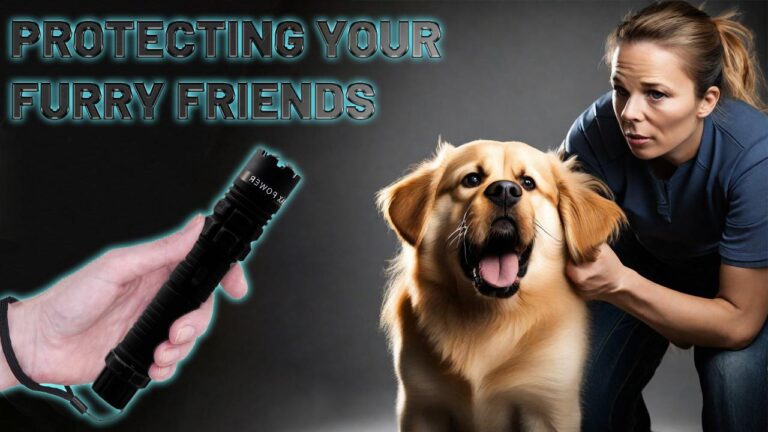Table of Contents
- Understanding How Stun Guns Affect Aggressive Animals
- Assessing When It Is Appropriate To Use A Stun Gun
- Step By Step Guide To Using A Stun Gun Safely On Aggressive Animals
- Essential Safety Precautions And Legal Considerations For Stun Gun Use
- The Way Forward
Understanding How Stun Guns Affect Aggressive Animals
When a stun gun is deployed on an aggressive animal, it works by delivering a powerful but controlled electric shock that disrupts the animal’s muscular and nervous systems temporarily. This incapacitation allows you to create a safe distance without causing permanent harm. The shock interferes with the animal’s voluntary muscle control, often causing confusion or disorientation, which is crucial in diffusing potentially dangerous encounters. It’s important to recognize that the effectiveness of a stun gun depends on factors such as the animal’s size, species, and level of aggression.
To maximize safety and efficacy, consider these key points:
- Target areas: Aim for larger muscle groups like the shoulders or hindquarters for the best impact.
- Stun duration: Keep the shocks brief but sufficient, usually no more than a few seconds at a time.
- Distance: Maintain an optimal range to avoid close contact, reducing your risk of bites or scratches.
- Animal behavior: Be aware that some animals may not respond immediately and could become more agitated, requiring repeated application or alternative solutions.
Assessing When It Is Appropriate To Use A Stun Gun
Before reaching for a stun gun in an encounter with an aggressive animal, it’s crucial to evaluate the situation carefully. This tool should never be the first line of defense but rather a last resort when non-violent deterrents have failed or are not feasible. Consider factors such as the animal’s size, species, and behavior-if the animal shows signs of escalating aggression or poses an immediate threat to your safety, use the stun gun promptly. However, if there’s an option to retreat or create distance, always prioritize those safer approaches.
Using a stun gun effectively also depends on your confidence and understanding of the device. Being reckless can increase the risk of unintended harm to both you and the animal. Keep these points in mind:
- Know your stun gun’s range and power: Ensure it’s suitable for the animal’s size and behavior.
- Assess your environment: Avoid situations where you might lose balance or become cornered while using the device.
- Understand legal restrictions: Certain areas may regulate or prohibit stun gun use against animals.
Step By Step Guide To Using A Stun Gun Safely On Aggressive Animals
Before engaging with an aggressive animal, ensure you have clear visibility and sufficient space to react. Always approach with caution and keep the stun gun in hand, ready to deploy but not activated prematurely. Aim for the animal’s torso or shoulder area, as direct contact improves the effectiveness of the stun and minimizes unnecessary harm. Maintain a safe distance, ideally at arm’s length, and avoid close face-to-face positioning to reduce the risk of bites or scratches.
When ready to use the stun gun, administer short bursts rather than continuous shocks to limit distress and avoid prolonged effects on the animal. After deployment, step back immediately and assess the animal’s behavior. If it continues to pose a threat, repeat briefly with controlled bursts. Remember to:
- Stay calm and composed to avoid escalating the encounter.
- Keep your environment in mind to ensure bystanders are safe.
- Do not rely solely on the stun gun – consider seeking professional animal control assistance if necessary.
Essential Safety Precautions And Legal Considerations For Stun Gun Use
When handling a stun gun, prioritizing personal and animal safety is crucial. Always ensure that you are familiar with its functions before use, and maintain a safe distance from the animal to minimize the risk of accidental harm. Keep the device in an accessible yet secure place to prevent unauthorized use, especially around children. Before activating, be aware of your surroundings to avoid unintended consequences, such as startling bystanders or causing unnecessary distress to other animals nearby.
Understanding the legal landscape governing stun gun possession and use is equally important. Laws vary widely depending on your location-some regions may restrict ownership, require permits, or prohibit their use on animals entirely. Be sure to research local regulations and comply with all applicable statutes to avoid penalties. Additionally, when using a stun gun on aggressive animals, document the incident if possible, as this may be necessary to demonstrate self-defense rather than misuse in legal proceedings.
- Wear protective gear when appropriate
- Check device functionality regularly
- Use stun guns only as a last resort
- Seek training on proper handling techniques
- Consult local laws before purchase or use
The Way Forward
In conclusion, while stun guns can be an effective tool for deterring aggressive animals, their safe and responsible use is paramount. Understanding how to operate the device properly, knowing the legal regulations in your area, and recognizing when and how to deploy it can make all the difference in protecting yourself without causing unnecessary harm. Always prioritize caution and respect for wildlife, and consider stun guns as one part of a broader safety strategy. Stay informed, stay prepared, and stay safe out there.Check Our Other Blogs
- StunGun – Your Trusted Source for Stun Guns, Laws, and Self-Defense Tips
- PepperSprayLaws – Your Trusted Resource for Pepper Spray Information
- StunGunLaws – Your Trusted Guide to Stun Gun Legality and Safety





